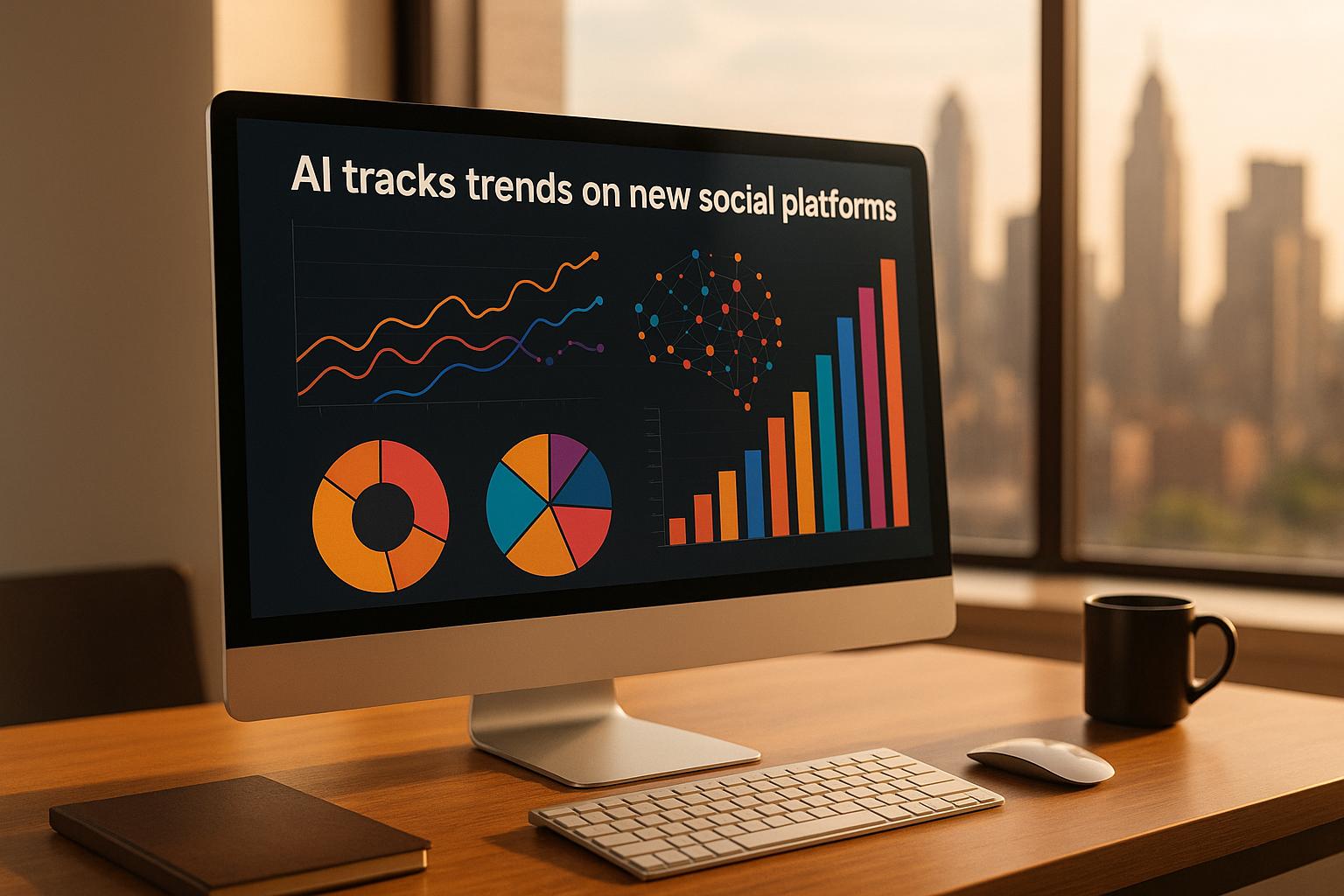Why it matters:
- Find market gaps: Spot where competitors fall short.
- Improve products: Learn what customers value most.
- Boost efficiency: AI processes reviews 50x faster than manual methods.
How AI helps:
- Sentiment analysis: Understand customer emotions from reviews.
- Trend detection: Identify recurring themes and shifts in preferences.
- Real-time insights: Adapt quickly to market changes.
Tools to use:
- Crayon: Monitors competitors in real-time; helped Salesforce cut churn by 7%.
- Kompyte: Automates tracking with AI-powered battle cards.
- Brandwatch: Excels in sentiment and trend analysis.
Key takeaway:
AI transforms raw data into actionable insights, helping businesses improve products, refine marketing, and enhance customer experience - all while saving time and reducing bias.
Ready to learn how? Dive into the details below.
Competitor review analysis powered by A.I.
AI Tools for Gathering and Analyzing Competitor Reviews
AI tools have revolutionized how businesses analyze competitor reviews. According to Gartner (2023), AI can cut review collection time by 70%, while MIT research highlights that AI achieves 95% accuracy in identifying relevant data - processing information 50 times faster than manual methods.
AI for Data Collection
AI-driven tools simplify the process of collecting reviews from various platforms. Using natural language processing (NLP) and web scraping, these tools automatically gather and refine data, removing irrelevant information.
Here are some core capabilities:
| Capability | Description | Impact |
|---|---|---|
| Automated Scraping | Monitors review sites continuously | Enables real-time updates |
| Multi-platform Integration | Aggregates data from multiple platforms | Ensures broad coverage |
| Smart Filtering | Filters spam and duplicates automatically | Delivers cleaner datasets |
| Language Processing | Handles reviews in multiple languages | Offers global insights |
These features ensure that raw data collection is efficient and ready for deeper analysis.
AI Tools for Competitor Review Analysis
Several AI platforms excel in transforming collected data into actionable insights:
- Crayon: This platform monitors competitors in real-time and flags anomalies. For example, Salesforce used Crayon in Q2 2023 to analyze reviews of its top 5 CRM competitors. The result? A 12% boost in customer satisfaction and a 7% drop in enterprise client churn.
- Kompyte: Known for its AI-powered battle cards, Kompyte automates competitor tracking. It holds a 4.6/5 rating on Capterra for its effectiveness.
- Brandwatch: Focused on consumer intelligence, Brandwatch uses AI for sentiment analysis and trend detection, helping businesses uncover patterns in competitor reviews.
Organizing Review Data
AI tools also excel at structuring messy review data. Forrester (2024) notes that AI reduces data preparation time by 80% while improving insight discovery by 60%.
Take IBM's Watson Discovery, for instance. This service uses automated categorization, smart tagging, and visual analytics to organize review data, making it easier to analyze competitors comprehensively.
AI Techniques for Analyzing Competitor Review Data
AI has revolutionized how businesses turn raw review data into insights. By analyzing reviews, companies can gauge customer sentiment, spot trends, and track mentions of specific products with impressive precision.
Sentiment Analysis of Customer Feedback
Sentiment analysis uses Natural Language Processing (NLP) to assess the emotional tone in customer reviews. Modern NLP tools are highly effective, even recognizing sarcasm and subtle context with 92% accuracy (Stanford NLP Group, 2024). This level of precision surpasses manual review methods.
Take Airbnb as an example: Their AI analyzed 10 million reviews and discovered that 68% of negative feedback centered on cleanliness. Acting on this, they updated their cleaning protocols, boosting their cleanliness scores by 23% within six months.
| Sentiment Type | What It Measures | Business Impact |
|---|---|---|
| Basic Sentiment | Positive/Negative/Neutral reactions | Tracks overall customer satisfaction |
| Priority Detection | Emotional intensity & context | Highlights areas needing immediate action |
| Feature-specific | Sentiment tied to product aspects | Guides product improvements |
Trend Identification with Topic Modeling
Topic modeling uses machine learning to identify recurring themes and patterns in review data. This method is invaluable for spotting changing customer preferences and new market opportunities. For instance, just as Airbnb used trend analysis to address cleanliness concerns, other businesses can use similar insights to find areas for improvement or innovation.
Entity Recognition for Key Mentions
Entity recognition focuses on identifying specific product mentions within reviews, helping companies prioritize product development and track competitor performance. This approach is particularly useful for uncovering market gaps and evaluating competitor weaknesses.
Here’s how it helps:
- Feature Tracking: Keeps tabs on how individual product features are received.
- Competitive Intelligence: Highlights strengths and weaknesses of competitors.
- Market Trends: Detects rising demand for new features and fading interest in older ones.
For example, analysis of smartphone reviews has revealed growing praise for 5G capabilities, while mentions of the headphone jack continue to decline. These insights directly inform research and development strategies.
sbb-itb-bec6a7e
Using AI Insights for Business Strategies
Expanding on earlier technical analysis methods, AI insights can directly shape three crucial areas of business strategy:
Improving Products and Services
A SaaS company in the UK achieved a 40% revenue boost by using AI to analyze competitor reviews. They identified workflow integration issues and streamlined their onboarding process, cutting the time by 40% [1].
Focus on developing features competitors are praised for, addressing frequent complaints, and setting quality standards through ongoing analysis.
Adjusting Marketing and Positioning
According to McKinsey (2024), small and medium-sized enterprises (SMEs) using AI-driven strategies saw an average 19% increase in revenue [2].
Here’s how AI can refine your marketing efforts:
- Spot Market Gaps: AI can highlight underserved customer segments and unmet needs, helping you create solutions that stand out.
- Sharpen Messaging: Sentiment analysis reveals which competitor messages resonate most with customers, enabling you to craft stronger, more appealing value propositions.
Improving Customer Experiences
Natural Language Processing (NLP) tools can analyze sentiment patterns, allowing businesses to elevate customer experiences by:
- Predicting Issues: Identify recurring complaints in competitor reviews to address potential problems proactively.
- Setting Benchmarks: Compare your response times to competitors and aim to improve.
- Personalizing Interactions: Use competitor feedback to design more tailored and engaging customer experiences.
Platforms like AI for Businesses offer affordable tools to implement these strategies effectively [3].
Ethical and Legal Considerations
According to Gartner, 71% of businesses cite data privacy as their top concern when using AI for competitive analysis. This concern shapes how companies apply analysis techniques while maintaining trust with their stakeholders.
Data Privacy Compliance
When handling review data, businesses must adhere to regulations like GDPR, CCPA, PIPEDA, and LGPD. Here are some key strategies to ensure compliance:
| Requirement | Implementation Strategy | Risk Mitigation |
|---|---|---|
| Data Collection | Use official APIs and authorized channels | Avoids legal issues tied to unauthorized scraping |
| Data Storage | Apply encryption and access controls | Safeguards sensitive information |
| Data Processing | Anonymize and aggregate review data | Minimizes risks of privacy violations |
| User Consent | Document and verify consent mechanisms | Ensures compliance with regulatory standards |
A great example is Salesforce, which created an AI Ethics Review Board led by Chief Ethical and Humane Use Officer Paula Goldman. This board oversees ethical AI practices, including the use of their Einstein AI platform for competitor analysis.
Bias in AI Analysis
Ethical challenges like algorithmic bias are just as critical as legal compliance. AI systems can unintentionally reinforce biases, leading to skewed competitor analysis. For instance, a study by MIT Technology Review found that 43% of AI systems exhibit gender bias when analyzing customer reviews.
To ensure fair and accurate AI-driven insights, businesses should:
- Use Diverse Data Sources: Regularly audit training data to avoid selection bias that could distort results.
- Introduce Human Oversight: Follow examples like Airbnb and Salesforce by having experts validate AI-generated insights before acting on them.
- Assess Models Regularly: Conduct quarterly evaluations of AI models with a focus on:
- Sentiment analysis accuracy across languages
- Consistent treatment of reviews, regardless of length
- Balanced consideration of historical and recent feedback
Additionally, the EU's proposed AI Act will soon introduce new compliance standards for review analysis tools. Companies should prepare by building strong data governance frameworks and documenting AI decision-making processes clearly.
Measuring Success and Improving AI Usage
Effective measurement is key to ensuring that AI tools deliver real business results. According to Forrester Research, companies using AI for competitive intelligence see 21% higher revenue growth compared to those relying on manual methods. For smaller businesses using platforms like AI for Businesses, tracking the right metrics helps maximize ROI from tools like review analysis systems.
Key Performance Indicators to Track
Measuring the success of AI competitor analysis requires looking at multiple areas. Here's a framework to help organizations track their progress:
| Performance Area | Key Metrics |
|---|---|
| Customer Insights | Sentiment score, NPS change |
| Market Position | Market share growth, competitive win rate |
| Operational Efficiency | Time saved in analysis, speed of insight implementation |
| Financial Impact | ROI on AI tools, cost savings |
Improving AI Models
Improving AI models involves continuous updates and refinements to ensure they perform better over time. Here are three key strategies:
1. Enhancing Data Quality
Focus on improving data validation processes and expanding data sources to include a wider range of competitor feedback channels. This ensures the model has diverse and accurate information to work with.
2. Optimizing the Model
Refining the AI model is a step-by-step process. Here's a breakdown:
| Phase | Action Items | Expected Outcome |
|---|---|---|
| Evaluation | Regular accuracy checks, bias assessments | Establish baseline performance |
| Refinement | Retrain with updated data, fine-tune parameters | 10-15% accuracy improvement |
| Validation | Conduct A/B tests, involve human experts | Confirm improved performance |
| Deployment | Monitor real-world outcomes | Stable and reliable performance |
3. Monitoring Performance
Keep an eye on model accuracy and its impact on business goals by tracking measurable outcomes. Integrating these metrics into broader business intelligence systems ensures AI insights directly inform strategic decisions.
Organizations should review these metrics and improvements regularly, ideally on a quarterly basis. This approach keeps AI models relevant, identifies areas for growth, and ensures they contribute meaningfully to competitive strategies. Such practices pave the way for more informed decision-making and sustained business success.
Conclusion and Key Points
Key Takeaways and Practical Steps
Using AI-powered competitor review analysis can help businesses respond faster to market changes and improve customer satisfaction. As we've discussed, the best results come from blending advanced AI tools with human expertise.
| Phase | Key Actions | Outcomes |
|---|---|---|
| Foundation | Assess data quality, choose tools | Establish a solid foundation |
| Integration | Train teams, align processes | Boost operational efficiency |
| Optimization | Validate regularly, keep learning | Gain sharper competitor insights |
"AI-powered competitor analysis is no longer a luxury for big corporations. It's becoming a necessity for SMEs to stay competitive in rapidly evolving markets." - Dr. Sarah Chen, AI Research Lead at MIT, Harvard Business Review.
Where SMEs Should Start
For small and medium-sized businesses, the focus should be on taking manageable steps to integrate these practices. By following the outlined phases, SMEs can make progress by:
- Evaluating Needs: Understand your current competitive analysis gaps and strengths.
- Choosing Tools: Pick AI tools that fit your business size and goals.
- Starting Small: Launch a pilot program targeting one or two key competitors to test and refine your approach.


